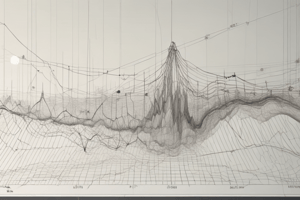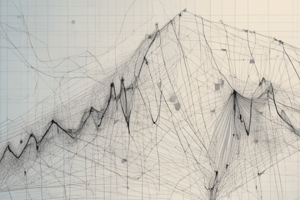Podcast
Questions and Answers
What is a primary advantage of data visualization facilitated by ICT?
What is a primary advantage of data visualization facilitated by ICT?
- It eliminates the need for statistical methods.
- It exclusively benefits only data scientists.
- It requires no knowledge of the underlying data.
- It simplifies complex data for better understanding. (correct)
Which method represents a challenge in historical data collection for analysis?
Which method represents a challenge in historical data collection for analysis?
- Highly sophisticated software tools.
- Limited methods for data collection and storage. (correct)
- Abundance of available data.
- Immediate digital access to data.
What role do theoretical frameworks play in the development of data science methodologies?
What role do theoretical frameworks play in the development of data science methodologies?
- They exclusively focus on computer hardware advancements.
- They have no influence on methodology development.
- They provide context and inform the methodologies used. (correct)
- They hinder new approaches and techniques.
What was a significant limitation of early data analysis due to computational constraints?
What was a significant limitation of early data analysis due to computational constraints?
Which option accurately reflects historical applications of data science?
Which option accurately reflects historical applications of data science?
How have ethical considerations regarding data analysis evolved historically?
How have ethical considerations regarding data analysis evolved historically?
What was an early use of computational infrastructure in data analysis?
What was an early use of computational infrastructure in data analysis?
What does networked data transfer primarily enable in modern data science?
What does networked data transfer primarily enable in modern data science?
What is the main purpose of using a line graph?
What is the main purpose of using a line graph?
Which type of graph is best suited for highlighting the distribution of a single continuous variable?
Which type of graph is best suited for highlighting the distribution of a single continuous variable?
What key feature distinguishes scatter plots from other graph types?
What key feature distinguishes scatter plots from other graph types?
What is a major drawback of pie charts in data analysis?
What is a major drawback of pie charts in data analysis?
Which ICT application is primarily responsible for storing and retrieving vast datasets in data science?
Which ICT application is primarily responsible for storing and retrieving vast datasets in data science?
What role does data processing play in data science according to ICT applications?
What role does data processing play in data science according to ICT applications?
Which of the following graphs is particularly effective for showcasing the central tendency and spread of data?
Which of the following graphs is particularly effective for showcasing the central tendency and spread of data?
What is the main use of area charts in data visualization?
What is the main use of area charts in data visualization?
Flashcards
Line graph
Line graph
Used to show trends over time, where a variable changes continuously. The x-axis is usually time, and the y-axis represents the value being measured.
Bar graph
Bar graph
Used to compare different categories or groups. Each bar represents a specific value within a category.
Scatter plot
Scatter plot
Shows the relationship between two variables. Each point on the graph represents a data point, visualizing the correlation or lack of correlation between the variables.
Histogram
Histogram
Signup and view all the flashcards
Pie chart
Pie chart
Signup and view all the flashcards
Area chart
Area chart
Signup and view all the flashcards
Box plot
Box plot
Signup and view all the flashcards
Data storage and retrieval
Data storage and retrieval
Signup and view all the flashcards
Data Visualization with ICT
Data Visualization with ICT
Signup and view all the flashcards
Collaboration in Data Science
Collaboration in Data Science
Signup and view all the flashcards
Networked Data Transfer
Networked Data Transfer
Signup and view all the flashcards
Early Data Analysis Methods
Early Data Analysis Methods
Signup and view all the flashcards
Computational Limitations in the Past
Computational Limitations in the Past
Signup and view all the flashcards
Data Availability and Collection Historically
Data Availability and Collection Historically
Signup and view all the flashcards
Theory's Role in Early Data Science
Theory's Role in Early Data Science
Signup and view all the flashcards
Historical Applications of Data Science
Historical Applications of Data Science
Signup and view all the flashcards
Study Notes
Different Types of Graphs Used For
- Line graphs display trends over time, showing continuous variable changes. X-axis is time or another continuous variable, Y-axis shows the measured value.
- Bar graphs compare categories or groups. Each bar's height represents a category's value. Used for discrete data.
- Scatter plots show the relationship between two variables. Points represent data points, highlighting correlation or lack thereof.
- Histograms represent the distribution of a single continuous variable. X-axis shows ranges of values, bar height shows frequency within ranges. Useful for identifying distribution shapes (e.g., normal, skewed).
- Pie charts display proportions of categories as slices. Show relative sizes, but less insightful for detailed comparisons.
- Area charts show accumulated values over time, similar to line charts, but the area under the line is filled. Visualize cumulative totals.
- Box plots visualize a variable's distribution across categories. Displays median, quartiles, and potential outliers for central tendency, spread, and skewness.
ICT Applications in Data Science
- Data storage and retrieval use robust ICT systems for large datasets. Databases like SQL and NoSQL efficiently store and retrieve data. Cloud-based storage enhances scalability and accessibility.
- ICT enables fast data processing and analysis, supporting complex techniques like machine learning using computing power and algorithms. Python libraries like Pandas and Scikit-learn are key tools.
- ICT creates sophisticated visualizations such as interactive dashboards and graphs improving data understanding and actionability for stakeholders.
- ICT provides platforms for communication and collaboration amongst data scientists. This allows insightful sharing and work progress.
- ICT handles large dataset transfer across networks, bridging geographical gaps and facilitating collaboration among geographically dispersed teams.
Historical Questions in Data Science
- Early analysis methods explored how statisticians and mathematicians analyzed data without modern computational tools. Understanding early approaches provides context for modern techniques.
- Computational limitations of the past influenced data science scope and approaches. Awareness of historical constraints provides perspective on today's possibilities.
- Historical data collection and storage methods reveal challenges in data analysis. This perspective sheds light on modern collection strategies and accessibility impacts on progress.
- Theoretical frameworks shaped the early development of data science methodologies, contextualizing existing approaches.
- Historical applications of data science, such as census data and epidemiological studies, demonstrate the use of data to solve real-world problems. These case studies offer insightful patterns in data use.
- Algorithms and computational techniques have significantly changed throughout data science history. Evaluating these transformations aids in predicting future trends and development.
- Ethical considerations related to bias, fairness, and privacy regarding data and analysis have been explored historically. Examining these concerns in the past informs modern ethical frameworks.
- Early computational infrastructure for data analysis highlights early limitations and the pathway to modern capabilities.
Studying That Suits You
Use AI to generate personalized quizzes and flashcards to suit your learning preferences.




